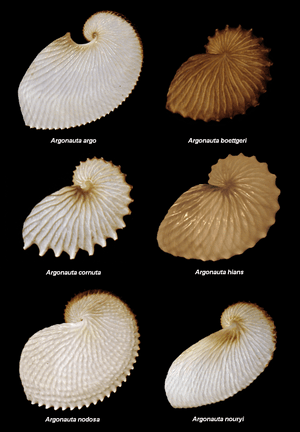Argonauta facts for kids
Quick facts for kids ArgonautsTemporal range: Miocene – Recent
|
|
|---|---|
 |
|
| Eggcases of various Argonauta species | |
| Scientific classification | |
| Kingdom: | |
| Phylum: | |
| Class: | |
| Order: | |
| Superfamily: |
Argonautoida
|
| Family: |
Argonautidae
|
| Genus: |
Argonauta
Linnaeus, 1758
|
Argonauta, also known as argonauts, are a special type of octopus. They are the only living members of the Argonautidae family. These amazing creatures live in the open ocean, floating near the surface.
They are often called paper nautiluses because of the thin, paper-like shell that female argonauts create. This shell is not like the hard shells of other sea creatures. It's a unique structure made by the female argonaut herself.
Argonauts live in warm, tropical and subtropical waters around the world. Like most octopuses, they have a round body and eight arms. But unlike octopuses that live on the seafloor, argonauts spend their lives swimming freely in the water. They have very large eyes and can be identified by a special locking system between their body and funnel.
Contents
The Female's Amazing Eggcase
What is an Eggcase?
Female argonauts build a unique, thin eggcase out of a material similar to chalk. This eggcase looks a bit like the shells of ancient, extinct creatures called ammonites. The female makes this case using two of her special arms, which are much wider than the others.
How it's Used
After she lays her eggs, the female argonaut lives inside this floating eggcase. She often keeps her head and arms sticking out of the opening. If she feels scared, she can pull herself deeper inside for safety.
These beautiful, curved white eggcases are sometimes found floating on the ocean surface. You might even see a female argonaut still holding onto hers! The eggcase is made of three layers and helps the argonaut float. It even contains a bubble of gas for buoyancy, similar to how some shelled sea creatures float.
Size Differences
The largest argonaut species is Argonauta argo. Its eggcase can grow up to 300 millimeters (about 12 inches) long. The smallest species is Argonauta bottgeri, with an eggcase only about 67 millimeters (about 2.6 inches) long.
How Argonauts Eat and Protect Themselves
What They Eat
Argonauts usually hunt for food during the day. They use their arms to grab prey and pull it towards their mouth. Then, they bite the prey and inject it with poison from their salivary gland. They eat small crabs, molluscs, jellyfish, and even other floating sea creatures called salps. If their prey has a shell, the argonaut can drill into it before injecting the poison.
Staying Safe from Predators
Argonauts are very good at changing their color. This helps them blend in with their surroundings, making it harder for predators to spot them. If an argonaut is attacked, it can squirt out a cloud of ink. This ink confuses the attacker's sense of smell, giving the argonaut time to escape. The female argonaut can also quickly pull back the web on her shell, creating a bright, silvery flash. This sudden flash might scare away a predator.
Who Eats Argonauts?
Larger sea animals like tunas, billfishes, and dolphins hunt argonauts. Their shells and remains have been found in the stomachs of fish like the Alepisaurus ferox and Coryphaena hippurus.
Interestingly, male argonauts have sometimes been seen living inside salps, which are clear, barrel-shaped creatures that float in the ocean. Scientists are still learning about this unusual relationship.
Types of Argonauts
There are about seven different types of argonauts living today. Scientists also know about several types of argonauts that are now extinct.
Images for kids
-
Argonauts surrounding the Nautilus, in Jules Verne's novel Twenty Thousand Leagues Under the Sea
See also
 In Spanish: Argonauta (desambiguación) para niños
In Spanish: Argonauta (desambiguación) para niños







